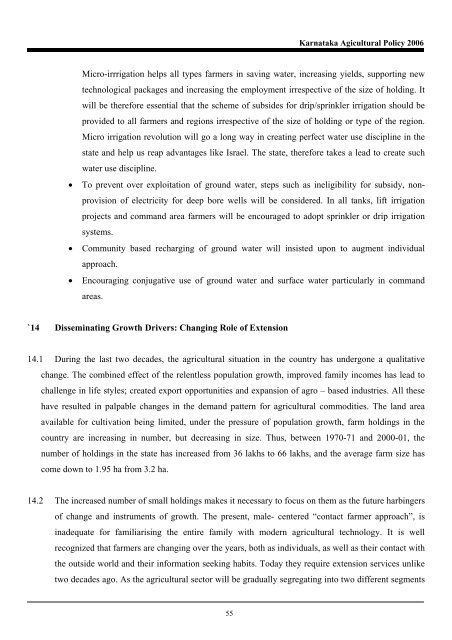Karnataka Agricultural Policy - Institute for Social and Economic ...
Karnataka Agricultural Policy - Institute for Social and Economic ...
Karnataka Agricultural Policy - Institute for Social and Economic ...
Create successful ePaper yourself
Turn your PDF publications into a flip-book with our unique Google optimized e-Paper software.
<strong>Karnataka</strong> Agicultural <strong>Policy</strong> 2006<br />
Micro-irrrigation helps all types farmers in saving water, increasing yields, supporting new<br />
technological packages <strong>and</strong> increasing the employment irrespective of the size of holding. It<br />
will be there<strong>for</strong>e essential that the scheme of subsides <strong>for</strong> drip/sprinkler irrigation should be<br />
provided to all farmers <strong>and</strong> regions irrespective of the size of holding or type of the region.<br />
Micro irrigation revolution will go a long way in creating perfect water use discipline in the<br />
state <strong>and</strong> help us reap advantages like Israel. The state, there<strong>for</strong>e takes a lead to create such<br />
water use discipline.<br />
• To prevent over exploitation of ground water, steps such as ineligibility <strong>for</strong> subsidy, nonprovision<br />
of electricity <strong>for</strong> deep bore wells will be considered. In all tanks, lift irrigation<br />
projects <strong>and</strong> comm<strong>and</strong> area farmers will be encouraged to adopt sprinkler or drip irrigation<br />
systems.<br />
• Community based recharging of ground water will insisted upon to augment individual<br />
approach.<br />
• Encouraging conjugative use of ground water <strong>and</strong> surface water particularly in comm<strong>and</strong><br />
areas.<br />
`14<br />
Disseminating Growth Drivers: Changing Role of Extension<br />
14.1 During the last two decades, the agricultural situation in the country has undergone a qualitative<br />
change. The combined effect of the relentless population growth, improved family incomes has lead to<br />
challenge in life styles; created export opportunities <strong>and</strong> expansion of agro – based industries. All these<br />
have resulted in palpable changes in the dem<strong>and</strong> pattern <strong>for</strong> agricultural commodities. The l<strong>and</strong> area<br />
available <strong>for</strong> cultivation being limited, under the pressure of population growth, farm holdings in the<br />
country are increasing in number, but decreasing in size. Thus, between 1970-71 <strong>and</strong> 2000-01, the<br />
number of holdings in the state has increased from 36 lakhs to 66 lakhs, <strong>and</strong> the average farm size has<br />
come down to 1.95 ha from 3.2 ha.<br />
14.2 The increased number of small holdings makes it necessary to focus on them as the future harbingers<br />
of change <strong>and</strong> instruments of growth. The present, male- centered “contact farmer approach”, is<br />
inadequate <strong>for</strong> familiarising the entire family with modern agricultural technology. It is well<br />
recognized that farmers are changing over the years, both as individuals, as well as their contact with<br />
the outside world <strong>and</strong> their in<strong>for</strong>mation seeking habits. Today they require extension services unlike<br />
two decades ago. As the agricultural sector will be gradually segregating into two different segments<br />
55

















